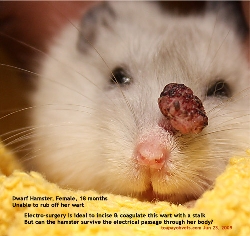 The
hamster's nose wart had a stalk
made up of normal skin. If I used
the scalpel to cut off the stalk,
there would be a lot of bleeding.
Shooting blood spurting all over
her face. If the hamster was a dog
or had a longer stalk, I could
ligate the stalk. The stalk was
the passage for large blood
vessels to supply nutrients to the
fast-growing wart. A wart bigger
than the hamster's eyes in this
case I am writing about.
The
hamster's nose wart had a stalk
made up of normal skin. If I used
the scalpel to cut off the stalk,
there would be a lot of bleeding.
Shooting blood spurting all over
her face. If the hamster was a dog
or had a longer stalk, I could
ligate the stalk. The stalk was
the passage for large blood
vessels to supply nutrients to the
fast-growing wart. A wart bigger
than the hamster's eyes in this
case I am writing about. "She rubbed off the wart previously," the teenaged girl who was accompanied by her concerned parents told me. "But the wart came back." Now, I had to decide whether to do electrosurgery on this hamster or not.
Could the hamster survive electric currents coursing through her body? What happens if the electrical circuit did not close completely. Would this old hamster be burnt or die out of shock? I doubt many vets will perform electrosurgery on hamsters to remove a wart. It sounded too risky.
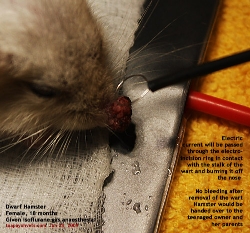 In
theory, the hamster should not get
electrical burns if the circuit
was well connected. The electric
current would flow from one
electrode out of the machine, pass
the hamster's stalk, incising and
coagulating the tumour and back to
the machine.
In
theory, the hamster should not get
electrical burns if the circuit
was well connected. The electric
current would flow from one
electrode out of the machine, pass
the hamster's stalk, incising and
coagulating the tumour and back to
the machine. To ensure the smooth flow of electric current without burning harming the patient or doctor, the following must be done:
1. A plastic sheet on the operating table which is metallic.
2. Normal saline on the gauze which is then placed on top of the pad of the indifferent (neutral) electrode. Saline, unlike water, conducts electricity well so that the current goes home via the indifferent electrode back to the machine.
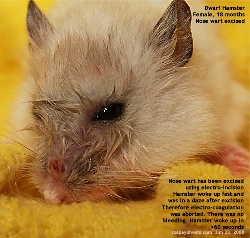 3.
The hamster's lower body must be
in full contact with the
gauze. If the contact is not good,
the surgeon or patient gets
electrical burns - common in human
electrosurgery where burns appears
on the back of patients or hands
of surgeons. In the case of
hamsters, I guess it will be much
more serious. The more upmarket
(expensive) electrosurgery machine
does not function if the contact
is not good. But it is NOT
feasible in a general-practice veterinary surgery to
purchase such expensive machines.
3.
The hamster's lower body must be
in full contact with the
gauze. If the contact is not good,
the surgeon or patient gets
electrical burns - common in human
electrosurgery where burns appears
on the back of patients or hands
of surgeons. In the case of
hamsters, I guess it will be much
more serious. The more upmarket
(expensive) electrosurgery machine
does not function if the contact
is not good. But it is NOT
feasible in a general-practice veterinary surgery to
purchase such expensive machines. 4. No saline should be present outside the indifferent electrode or the operating table. Use a plastic sheet to cover the operating table.
5. No explosive anaesthetic gas to be used.
6. The hamster must be fully anaesthesized, otherwise it would move about.
7. No sparks should be seen if the procedure is well done as there would then be no resistance to the current flow.
8. The lowest intensity should be used for electroincision and electrocoagulation modes. I intended to incise and then coagulate the wound.
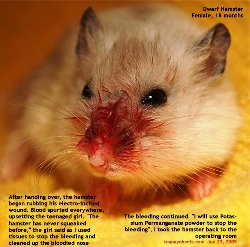
9. An alternative is the use of the blending mode (known as "coagulation 2" in my machine). In the blending mode, the wart is incised and coagulated at the same time. It would be ideal in this case. A bipolar electrode (2 electrodes held by the surgeon to incise and coagulate a small area like the stalk in this case) would be useful but it is costly and present only in expensive electrosurgery machines.
Anaesthesia
The hamster was given isoflurane gas in a container for a few seconds. When she was observed to be "sleepy", she was taken out, put on the saline-wetted gauze on top of the indifferent plate.
Electrosurgery
I used forceps to lift up the nose wart. The electroincision wire cut the stalk. There was resistance to the cutting. So I had to increase the intensity of the current. The hamster woke up suddenly and seemed shell shocked just after the passage of the electric current.
That is the problem with using gas isoflurane. It enabled rapid recovery. I had cut 80% of the stalk. There was no return. Quickly I stepped on the foot switch and lanced off the last piece of skin attachment.
There was no bleeding. That was excellent. Previously, I had bloodied noses after excision of the wart with scalpel. This was great. I took the hamster to the consultation room and handed her over to the teenaged girl. She was very happy to see the wart gone.
The hamster was much awakened now. Suddenly the girl said, "My hamster rubbed her nose. It is bleeding a lot." This bleeding was profuse. As if a dam had burst. I took a piece of tissue and put pressure on the nose to stop the bleeding. I wiped the blood away with another tissue. Still there was bleeding.
The hamster moved away from my fingers. Suddenly she squeaked as I pressed the tissue paper in an attempt to stem the flood of bright red blood spurting all over the hamster's face.
"I have never heard my hamster squeak before," the girl sounded distressed. I realise that I had to take the hamster away from the girl, back into the operating room to treat the bleeding. This bleeding was not life-threatening but it was very traumatic for the owner to watch and hard to explain to the owner. "I will use potassium permanganate powder to cauterise the wound," I said to the teenaged girl. "Have you studied this chemical in your class?" She shook her head. Probably she was in Secondary Two and had not studied chemistry. So she had not heard of this chemical.
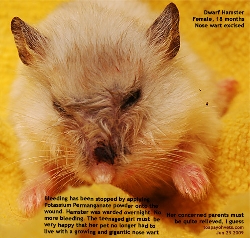 In
the silence and peace of the
operating room, I wiped off the
blood from the hamster's nose,
applied potassium permanganate
powder. There was no bleeding.
Now, the hamster had a purplish
black nose. Later one, she would
have her normal coloured nose.
In
the silence and peace of the
operating room, I wiped off the
blood from the hamster's nose,
applied potassium permanganate
powder. There was no bleeding.
Now, the hamster had a purplish
black nose. Later one, she would
have her normal coloured nose. In this case, the alternative blending or "coagulation 2" mode might be more useful in the electrosurgical excision of the big hamster wart. As very few hamster surgeries are done, I would have to wait for the next case. Not many hamster owners have problems with warts. This case showed that electrosurgery is all right with hamsters if good care is taken and a sound knowledge of the physics of electrosurgery is acquired.
Life is a continuous learning and hands-on experience is the only way for the vet to hone his skills in electrosurgery of the hamster. Unfortunately, there are not many cases for most vets and not all hamster tumour cases justify electrosurgery. An e-collar was one possible solution.
FEEDBACK FROM THE OWNER - Elizabeth Collar For the Hamster?
The teenaged girl had asked whether I had an e-collar for this hamster, thereby preventing rubbing and the subsequent bleeding. Well, hamsters don't like e-collars and they spend a lot of time trying to get rid of it. In the process of exertion, I am afraid that the old hamster might die of heart failure due to stress. In hamsters, the vet must not forget that it dies of stress easily and that it loses body temperature rapidly and dies due to hypothermia.
The hamster' surface area is large compared to its weight and size. The operating room should not be air-conditioned during hamster anaesthesia and surgery and that no water should dampen the hamster's body in the course of surgery.
 TOA
PAYOH VETS
TOA
PAYOH VETS